一、ASP.NET MVC核心机制回顾
在ASP.NET MVC中,最核心的当属“路由系统”,而路由系统的核心则源于一个强大的System.Web.Routing.dll组件。

在这个System.Web.Routing.dll中,有一个最重要的类叫做UrlRoutingModule,它是一个实现了IHttpModule接口的类,在请求处理管道中专门针对ASP.NET MVC请求进行处理。首先,我们要了解一下UrlRoutingModule是如何起作用的。
(1)IIS网站的配置可以分为两个块:全局 Web.config 和本站 Web.config。Asp.Net Routing属于全局性的,所以它配置在全局Web.Config 中,我们可以在如下路径中找到:“$\Windows\Microsoft.NET\Framework\版本号\Config\Web.config“
<?xml version="1.0" encoding="utf-8"?> <!-- the root web configuration file --> <configuration> <system.web> <httpModules> <add name="UrlRoutingModule-4.0" type="System.Web.Routing.UrlRoutingModule" /> </httpModules> </system.web> </configuration>
(2)通过在全局Web.Config中注册 System.Web.Routing.UrlRoutingModule,IIS请求处理管道接到请求后,就会加载 UrlRoutingModule类型的Init()方法。
PS : 在UrlRoutingModule中为请求处理管道中的第七个事件PostResolveRequestCache注册了一个事件处理方法:OnApplicationPostResolveRequestCache。从这里可以看出:ASP.NET MVC的入口在UrlRoutingModule,即订阅了HttpApplication的第7个管道事件PostResolveRequestCahce。换句话说,是在HtttpApplication的第7个管道事件处对请求进行了拦截。

现在我们将ASP.NET MVC的请求处理分为两个重要阶段来看看:
①在第七个事件中创建实现了IHttpHandler接口的MvcHandler
当请求到达UrlRoutingModule的时候,UrlRoutingModule取出请求中的Controller、Action等RouteData信息,与路由表中的所有规则进行匹配,若匹配,把请求交给IRouteHandler,即MVCRouteHandler。我们可以看下UrlRoutingModule的源码来看看,以下是几句核心的代码:
 View Code
View Code
从源码片段中可以看出,最后将请求转移给了实现了IHttpHandler接口的处理程序进行后续的处理。在ASP.NET MVC的实现中,是将请求交给了MvcHandler这个类,通过执行其ProcessRequest方法来进行后续的处理。

②在第十一个事件与第十二个事件之间调用MvcHandler的ProcessRequest()方法
(1)在WebForm中,此阶段会调用Page类对象的ProcessRequest()方法。在ASP.NET MVC中,会调用MvcHandler的ProcessRequest()方法,此方法会激活具体请求的Controller类对象,触发Action方法,返回ActionResult实例。
(2)如果ActionResult是非ViewResult,比如JsonResult, ContentResult,这些内容将直接被输送到Response响应流中,显示给客户端;如果是ViewResult,就会进入下一个渲染视图环节。
(3)在渲染视图环节,ViewEngine找到需要被渲染的视图,View被加载成WebViewPage<TModel>类型,并渲染生成Html,最终返回Html。

二、我的MVC框架核心部分介绍
2.1 解决方案概览
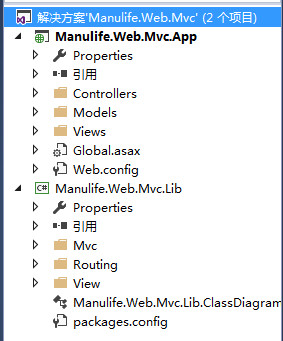
在该解决方案中,一共有两个项目:
一个是App,它是一个由最小化的引用环境(只引用了System和System.Web,以及Mvc.Lib)搭建起来的一个Web应用项目,借助MVC核心类库(Mvc.Lib)实现了MVC模式。
一个是Lib,它是一个模拟ASP.NET MVC框架的最小化、轻量级的迷你MVC框架,其中Mvc文件夹模拟System.Web.Mvc,Routing文件夹模拟System.Web.Routing,而View则简单地借助NVelocity模板引擎提供View视图服务。
2.2 MVC核心类库
(1)Routing

从第一部分我们可以知道,ASP.NET MVC的入口在于UrlRoutingModule,因此这里我们便模拟实现了一个UrlRoutingModule.
/// <summary> /// 解析请求中的路由数据,并分发请求到Handler /// </summary> public class UrlRoutingModule : IHttpModule { public void Init(HttpApplication application) { // 注册ASP.NET请求处理管道的第七个事件 application.PostResolveRequestCache += Application_PostResolveRequestCache; } // 假设请求 http://www.edisonchou.cn/home/index private void Application_PostResolveRequestCache(object sender, EventArgs e) { var application = sender as HttpApplication; var context = application.Context; // 根据全局路由表解析当前请求的路径 var requestUrl = context.Request.AppRelativeCurrentExecutionFilePath.Substring(2); // 遍历全局路由表中的路由规则解析数据 IDictionary<string, object> routeData; var route = RouteTable.MatchRoutes(requestUrl, out routeData); if (route == null) { // 404 Not Found throw new HttpException(404, "Not Found!"); } // 获取处理请求的Handler处理程序 if (!routeData.ContainsKey("controller")) { // 404 Not Found throw new HttpException(404, "Not Found!"); } var handler = route.GetRouteHandler(routeData); // 为当前请求指定Handler处理程序 context.RemapHandler(handler); } public void Dispose() { this.Dispose(); } }
该UrlRoutingModule通过注册ASP.NET请求处理管道的第七个事件,来实现对URL地址进行路由规则的处理,并将最后生成的路由数据交给MvcHandler进行后续处理。这里我省略了ASP.NET MVC源码中MvcRouteHandler生成MvcHandler的步骤,直接丢给MvcHandler处理。
核心部分有两点,一是路由规则的匹配,二是为请求指定handler。
在路由规则的匹配中,通过设置路由数据键值对(Dictionary),并将设置好的路有数据传递给MvcHandler。具体的流程如下图所示,这里就不再展示源码,请自行下载DEMO查看:
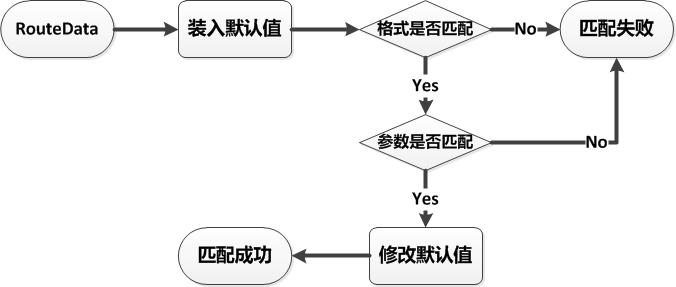
(2)Mvc
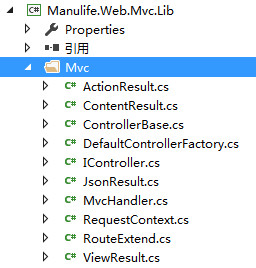
在此文件夹中,实现了三个核心的部分:
① 最核心的处理者 : MvcHandler
public class MvcHandler : IHttpHandler { private IDictionary<string, object> routeData; public MvcHandler(IDictionary<string, object> routeData) { this.routeData = routeData; } public void ProcessRequest(HttpContext context) { var controllerName = routeData["controller"].ToString(); // 借助控制器工厂创建具体控制器实例 IController controller = DefaultControllerFactory.CreateController(controllerName); // 确保有找到一个Controller处理请求 if (controller == null) { // 404 Not Found! throw new HttpException(404, "Not Found"); } // 封装请求 var requestContext = new RequestContext { HttpContext = context, RouteData = routeData }; // 开始执行 var result = controller.Execute(requestContext); result.Execute(requestContext); } public bool IsReusable { get { return false; } } }
在MvcHandler类中,主要经历了以下事件:

② 花样的返回类型 : ActionResult 以及它的子类们

在以往的ASP.NET MVC开发中,我们在Action方法的编写中,总会看到它们的返回类型都是以ActionResult为基类的各种Result类型。
/// <summary> /// Action统一的返回类型 /// </summary> public abstract class ActionResult { public abstract void Execute(RequestContext context); }
因此,这里也实现了ActionResult这个抽象类,并以此为基础实现了ContentResult、JsonResult以及ViewResult。它们的区别就在于是不同的返回类型,因此有不同的处理。
这里以ContentResult 和 JsonResult 为例,来看看具体做了什么处理。
[ContentResult]
public class ContentResult : ActionResult { private string content; private string contentType; public ContentResult(string content, string contentType) { this.content = content; this.contentType = contentType; } public override void Execute(RequestContext context) { context.HttpContext.Response.Write(content); context.HttpContext.Response.ContentType = contentType; } }
[JsonResult]
public class JsonResult : ActionResult { private object paraObj; public JsonResult(object paraObj) { this.paraObj = paraObj; } public override void Execute(RequestContext context) { JavaScriptSerializer jss = new JavaScriptSerializer(); var json = jss.Serialize(paraObj); context.HttpContext.Response.Write(json); context.HttpContext.Response.ContentType = "application/json"; } }
相信有经验的读者一眼就看穿了,因此这里也就不再多说了。
③ 路由的扩展者 : RouteExtend
在以往的ASP.NET MVC开发中,我们会在Global全局应用处理文件中为项目注册路由规则,但却不知道其实我们常用的MapRoute方法其实是一个扩展方法,它并不位于System.Web.Routing这个类库之中,而是位于System.Web.Mvc这个类库之中。
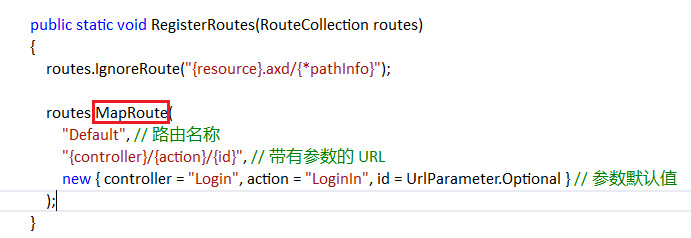
因此,我们也在Mvc文件夹中实现了一个RouteExtend类,它为RouteTable类的Route集合实现了一个扩展方法:
/// <summary> /// Route 的扩展方法所在类 /// </summary> public static class RouteExtend { /// <summary> /// 指定MvcHandler来处理 /// </summary> public static void MapRoute(this IList<Route> source, string urlTemplate, object defaults) { MapRoute(source, urlTemplate, defaults, routeData => new MvcHandler(routeData)); } /// <summary> /// 通过指定实现了IHttpHandler的处理程序来处理 /// </summary> public static void MapRoute(this IList<Route> source, string urlTemplate, object defaults, Func<IDictionary<string, object>, IHttpHandler> handler) { source.Add(new Route(urlTemplate, defaults, handler)); } }
可以看出,MvcHandler是在这里传入的(Mvc与Routing是单向依赖)。那么,为什么还要提供一个可传入自定义Handler的接口呢?因为,不同的路由规则有可能需要不同的实现IHttpHandler的处理程序来处理,也不一定就非得是MvcHandler。
(3)View
在ASP.NET MVC中提供了aspx与Razor等模板引擎,这里我偷了懒,直接借助了NVelocity模板引擎来实现。因此,这个文件夹中只有一个VelocityHelper类(我直接从网上搜索的),该类可以帮助我们找到指定的HTML并绑定Model实体。
 View Code
View Code
三、我的MVC框架应用实例
3.1 MVC 应用DEMO介绍
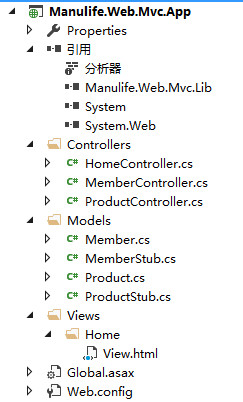
这是一个ASP.NET 空Web应用项目搭建起来的MVC Web应用项目,它移除了自带的所有引用项目,仅仅保留了System和System.Web,做到了尽可能地“纯净”。通过引入Mvc.Lib核心类库,建立Controller、Model和View文件夹以及对应的类和HTML来实现MVC模式。
(1)引入Mvc.Lib核心类库之后,需要配置一下Web.config,使UrlRoutingModule能够正常工作:
<system.web> <compilation debug="true" targetFramework="4.5"/> <httpRuntime targetFramework="4.5"/> <!-- HttpModule配置(IIS6版本) --> <httpModules> <add name="UrlRoutingModule" type="Manulife.Web.Mvc.Lib.Routing.UrlRoutingModule"/> </httpModules> </system.web> <system.webServer> <!-- 配置不去校验是否是集成模式 --> <validation validateIntegratedModeConfiguration="false"/> <!-- HttpModule配置(IIS7及以上版本) --> <modules> <add name="UrlRoutingModule" type="Manulife.Web.Mvc.Lib.Routing.UrlRoutingModule"/> </modules> </system.webServer>
(2)新建Global全局处理配置,在Application_Start事件中为项目添加路由规则:
public class Global : System.Web.HttpApplication { protected void Application_Start(object sender, EventArgs e) { // 注册路由规则1 RouteTable.Routes.MapRoute( urlTemplate: "{controller}/{action}/{id}", defaults: new { controller = "Home", action = "Index" } ); // 注册路由规则2 RouteTable.Routes.MapRoute( urlTemplate: "{controller}/{action}", defaults: new { controller = "Home", action = "Index" } ); // 注册路由规则3 RouteTable.Routes.MapRoute( urlTemplate: "{controller}", defaults: new { controller = "Home", action = "Index" } ); } }
(3)看看Controller是怎么写的?是不是很熟悉?
public class HomeController : ControllerBase { public ActionResult Index(int id, string controller, string action) { return new ContentResult(string.Format("<h1>Controller : {0}, Action : {1}, Id : {2}</h1>", controller, action, id), "text/html"); } public ActionResult View() { return new ViewResult(new { Id = 1, Name = "Edison Chou", Age = 27, Gender = true }); } }
(4)看看View中的HTML呢?这里使用NVelocity模板引擎提供的语法,操作Model实体对象。
<!DOCTYPE html> <html> <head> <meta http-equiv="Content-Type" content="text/html; charset=utf-8" /> <title>Index - View</title> <meta charset="utf-8" /> </head> <body> <h1>User Name : $model.Name</h1> <h1>User Age : $model.Age</h1> </body> </html>
3.2 MVC 应用DEMO演示
(1)默认路由 : home/index -> ContentResult

(2)请求JsonResult

(3)请求ViewResult

附件下载
Manulife.Web.Mvc : 点我下载
作者:周旭龙








 本文深入探讨了 ASP.NET MVC 的核心机制,重点介绍了路由系统的运作原理及其在请求处理管道中的作用。同时,文章还分享了一个轻量级的 MVC 框架实现案例,包括 MVC 架构的主要组成部分及其实现细节。
本文深入探讨了 ASP.NET MVC 的核心机制,重点介绍了路由系统的运作原理及其在请求处理管道中的作用。同时,文章还分享了一个轻量级的 MVC 框架实现案例,包括 MVC 架构的主要组成部分及其实现细节。

















 3290
3290

 被折叠的 条评论
为什么被折叠?
被折叠的 条评论
为什么被折叠?








